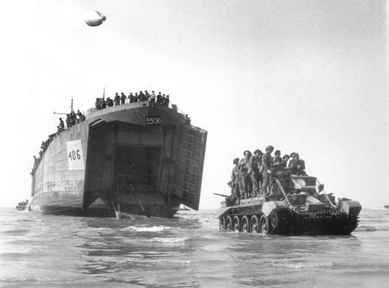D-Day

D-Day took place on June 6, 1944. The assult was conducted in two phases: an airborne assault landing of 24,000 British, American, Canadian and Free French airborne troops shortly after midnight, and an amphibious landing of Allied infantry and armored divisions on the coast of France. There were also decoy operations mounted under codenames to distract the German forces from the real landing areas. They would send out these codenames and false operations before invading in order to throw off the other troops. Also The Allies had to ensure that none of the plan was released – above all, the desire to fool the Germans that the Pays de Calais was the main target as opposed to Normandy.
The airborne assult into Normandy as part of the D-Day Allied invasion of Europe was the largest use of airborne troops up to that time. Paratroopers of the U.S. 82d and 101st Airborne divisions, the British 6th Airborne Division, the 1st Canadian Parachute Battalion, and other attached Allied units took part in the assault. To protect the invasion zone's western extremity and to facilitate the "Utah" landing force's movement into the Cotentin Peninsula, the U.S. 82nd and 101st Airborne divisions descended on the peninsula by parachute and glider in the early hours of D-Day.
There were three beaches involved in the amphibious assault. These beaches included Utah Beach, Omaha Beach, Gold Beach, Juno Beach, and Sword Beach.
The reason that Utah Beach was used was because the allies needed another major port as soon as possible. Utah Beach put seven U.S. Corps within 60 kilometers of Cherbourg at the outset.
Omaha Beach was a critical link between the Contentin peninsula and the flat plain in front of Caen. Omaha was also the most restricted and heavily defended beach, and for this reason at least one veteran U.S. Division was tasked to land there. The objective was to obtain a lodgment area between Port-en-Bessin and the Vire River and ultimately push forward to St. Lo and Caumont in order to cut German communications.
Gold Beach was the objective of the 50th Division of the British second Army. Its primary task was to seize Arrolnanches and drive inland to seize the road junction at Bayeux, as well as contact U.S. forces on their right and Canadians on their left.A major factor in their success was that the British assault forces were immensly equipped with armour and "Funnies" of the 79th Armoured Division.
Juno Beach was the landing area for 3rd Canadian Division. The 3rd Canadian Division broke through and advanced nearly to their objective, the airfield at Carpiquet, west of Caen.
Sword Beach was the objective of 3rd (British) Infantry Division. They were to advance inland as far as Caen, and line up with British Airborne forces east of the Orne River/Caen Canal. The Orne River bridges had been seized in late at night on the 5th of June by a glider-borne reinforced company commanded by Major John Howard. As at the other beaches, British forces penetrated quite a ways inland after breaking the opposition at water's edge.
The airborne assult into Normandy as part of the D-Day Allied invasion of Europe was the largest use of airborne troops up to that time. Paratroopers of the U.S. 82d and 101st Airborne divisions, the British 6th Airborne Division, the 1st Canadian Parachute Battalion, and other attached Allied units took part in the assault. To protect the invasion zone's western extremity and to facilitate the "Utah" landing force's movement into the Cotentin Peninsula, the U.S. 82nd and 101st Airborne divisions descended on the peninsula by parachute and glider in the early hours of D-Day.
There were three beaches involved in the amphibious assault. These beaches included Utah Beach, Omaha Beach, Gold Beach, Juno Beach, and Sword Beach.
The reason that Utah Beach was used was because the allies needed another major port as soon as possible. Utah Beach put seven U.S. Corps within 60 kilometers of Cherbourg at the outset.
Omaha Beach was a critical link between the Contentin peninsula and the flat plain in front of Caen. Omaha was also the most restricted and heavily defended beach, and for this reason at least one veteran U.S. Division was tasked to land there. The objective was to obtain a lodgment area between Port-en-Bessin and the Vire River and ultimately push forward to St. Lo and Caumont in order to cut German communications.
Gold Beach was the objective of the 50th Division of the British second Army. Its primary task was to seize Arrolnanches and drive inland to seize the road junction at Bayeux, as well as contact U.S. forces on their right and Canadians on their left.A major factor in their success was that the British assault forces were immensly equipped with armour and "Funnies" of the 79th Armoured Division.
Juno Beach was the landing area for 3rd Canadian Division. The 3rd Canadian Division broke through and advanced nearly to their objective, the airfield at Carpiquet, west of Caen.
Sword Beach was the objective of 3rd (British) Infantry Division. They were to advance inland as far as Caen, and line up with British Airborne forces east of the Orne River/Caen Canal. The Orne River bridges had been seized in late at night on the 5th of June by a glider-borne reinforced company commanded by Major John Howard. As at the other beaches, British forces penetrated quite a ways inland after breaking the opposition at water's edge.
